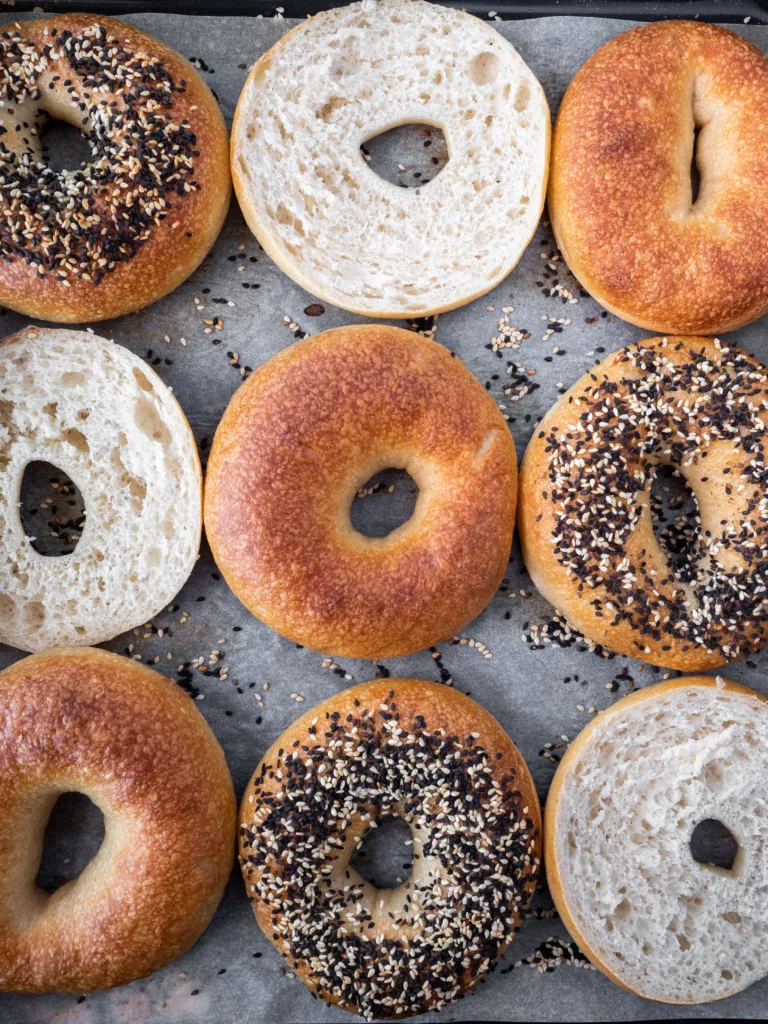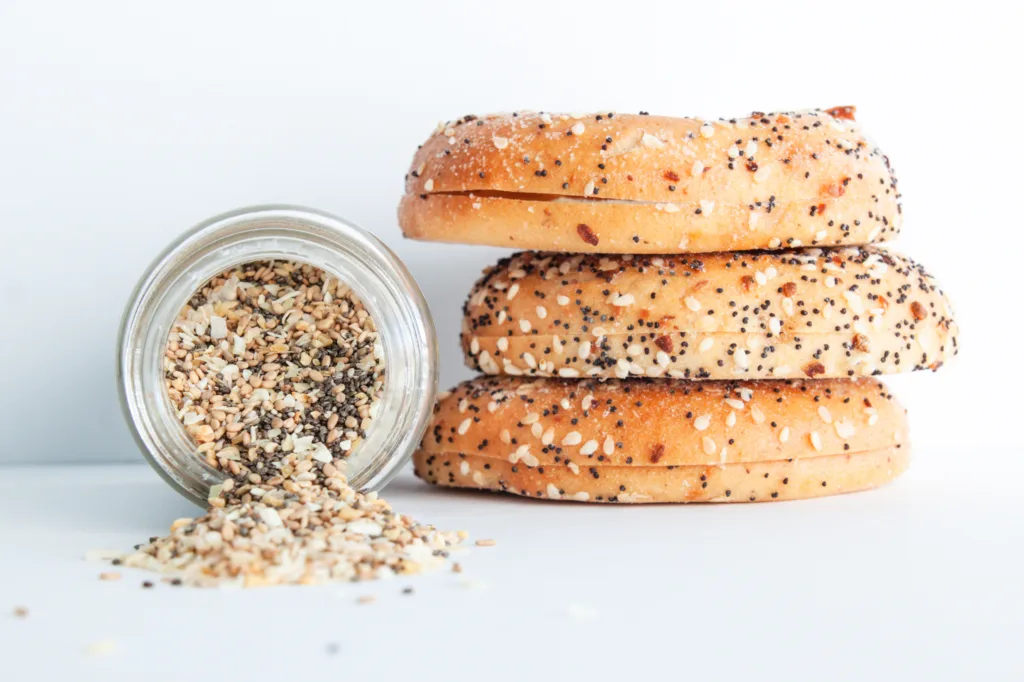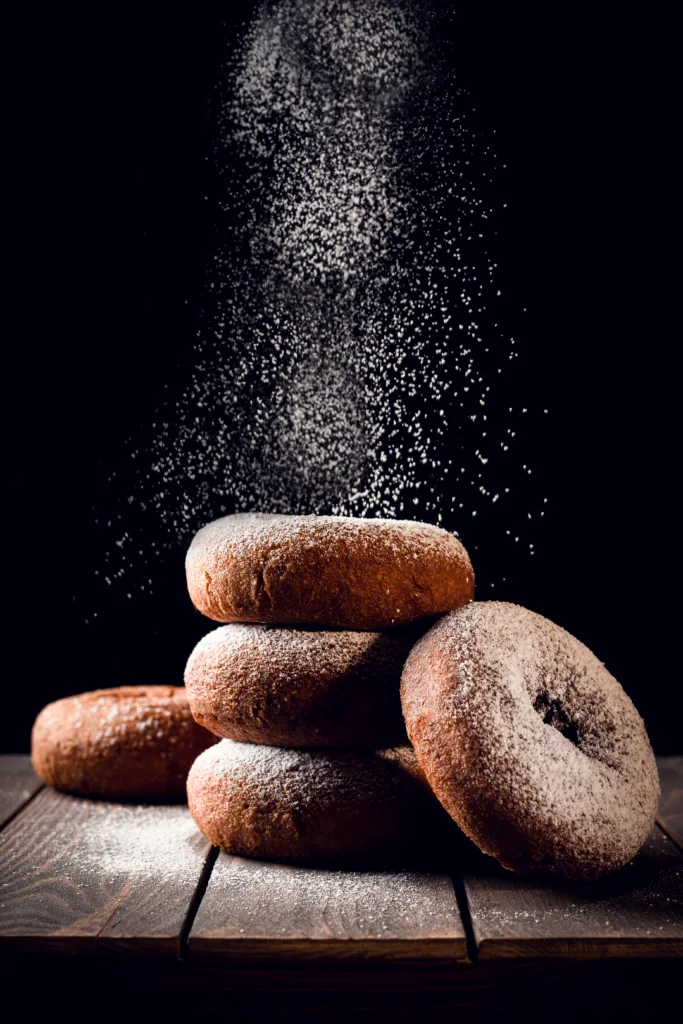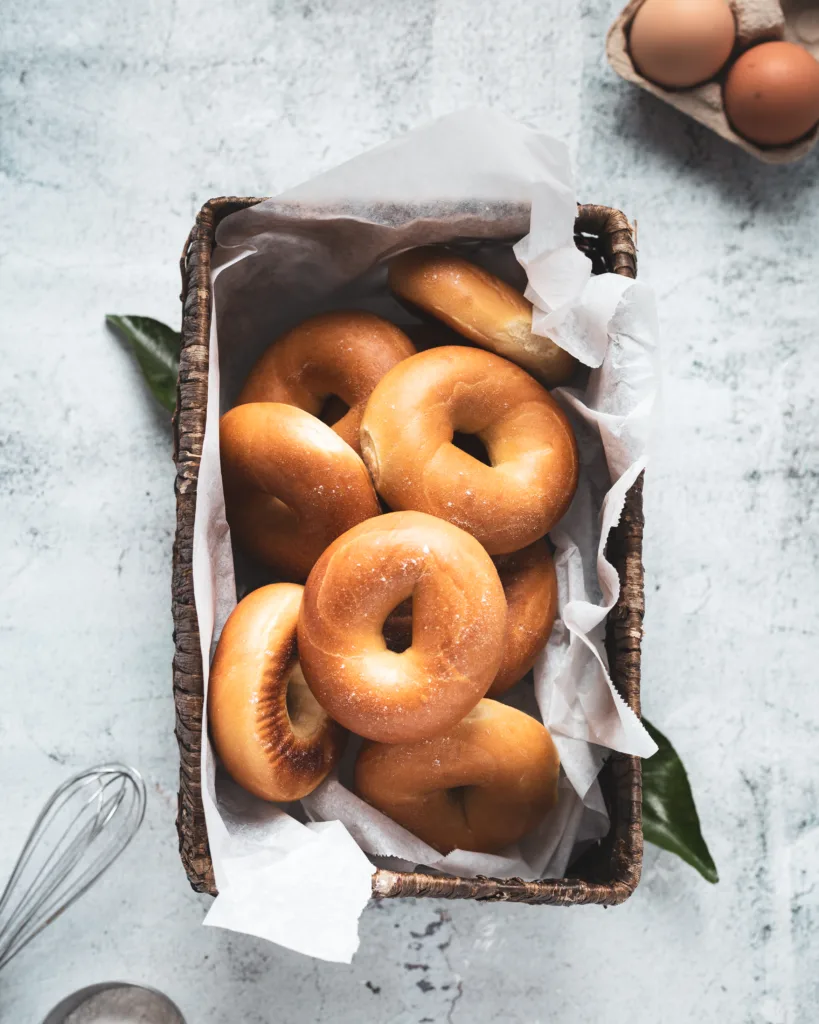Bagels are a beloved breakfast staple that are enjoyed by many people around the world. They have a rich history, dating back to the 16th century in Poland, and have become a popular food item in many cultures. But for those who are lactose intolerant or following a dairy-free diet, the question of whether bagels have dairy can be a concern.
So, do bagels have dairy? The answer is, it depends. Traditional bagels are typically made with flour, water, yeast, sugar, salt, and vegetable shortening. These ingredients do not contain dairy, making plain bagels a safe option for those avoiding dairy. However, some bagel recipes may include dairy products such as milk, butter, or cream cheese.
If you’re buying bagels from a bakery or grocery store, it’s important to check the ingredient list to ensure there are no dairy products included. Many bagel shops now offer dairy-free options, so it’s worth checking with the staff to see what options are available.
When it comes to bagel toppings, many popular spreads such as cream cheese, butter, and cheese are dairy-based. However, there are plenty of dairy-free options available that are just as delicious. Here are a few dairy-free bagel topping ideas:
1. Avocado: Mash up some ripe avocado and spread it on top of your bagel. Add a sprinkle of salt and pepper for added flavor.
2. Coconut butter: This creamy spread is made from pureed coconut meat and is a great dairy-free alternative to butter.
3. Baba ganoush: This Middle Eastern dip is made from roasted eggplant, tahini, lemon juice, and garlic. It’s a tasty and healthy option for your bagel.
4. Tofu cream cheese: Made from blended tofu and seasonings, this cream cheese alternative is a great vegan option.
5. Muhammara: This spicy Middle Eastern dip is made from roasted red peppers, walnuts, and spices. It’s a flavorful addition to any bagel.
6. Cashew cream cheese: Made from soaked cashews, lemon juice, and nutritional yeast, this cream cheese alternative is creamy and delicious.
While some bagel recipes may contain dairy, traditional bagels made with flour, water, yeast, sugar, salt, and vegetable shortening are dairy-free. When it comes to bagel toppings, there are plenty of dairy-free options available that are just as tasty as their dairy-based counterparts. So, go ahead and enjoy your bagels withot worrying about dairy!
Do Everything Bagels Contain Milk?
No, everything bagels do not contain milk. In fact, most bagels are dairy-free and made with simple ingredients such as flour, water, yeast, salt, sugar, and sometimes eggs. The “everything” seasoning on the bagel typically consists of sesame seeds, poppy seeds, onion, garlic, and salt. However, it is important to note that some bagel recipes may vary, and certain brands or bakeries may add milk or other dairy products to their bagels, so it is always best to check the ingredient list or ask the baker to confirm if you have a dairy allergy or intolerance.

Finding Dairy-Free Bagels
If you are looking for bagels that are free from dairy, there are several options available at varios coffee shops and bakeries. At Starbucks, you can try their sprouted grain, plain, blueberry, and walnut bagels, as all of these are dairy-free. If you are a fan of Panera Bread, you can opt for their cranberry, blueberry, walnut, poppyseed, and plain bagels, which are also free from dairy. Dunkin Donuts also has many dairy-free bagel options, including garlic, onion, everything, poppyseed, plain, salt, sesame, and cinnamon raisin. These bagels are suitable for individuals who are lactose intolerant or have a milk allergy, and they are a great option for those who are looking for a dairy-free breakfast or snack.
Are Bagels Vegan?
Not all bagels are vegan as some recipes may contain non-vegan ingredients such as eggs, milk, honey, or butter. It’s important to check the ingredients list or ask the bakery or manufacturer about the recipe to ensure that the bagels are vegan. However, many plain bagels are typically vegan as they are made from flour, water, yeast, sugar, salt, and some vegetable shortening. Additionally, some bagel flavors may also be vegan such as sesame, poppy seed, and plain cinnamon raisin. It’s alays important to double-check the ingredients and ask questions to ensure that the bagels align with your dietary preferences.
Lactose-Intolerant Bagel Toppings
If you are lactose intolerant and looking for delicious spreads to put on your bagel, there are several options available. One popular choice is avocado, which is a rich source of healthy fats and adds a creamy texture to your bagel. Another option is coconut butter, which is made from pureed coconut meat and has a slightly sweet and nutty flavor. Baba ganoush is a Middle Eastern spread made from roasted eggplants, tahini, and various seasonings, which provides a savory and smoky taste to your bagel. Tofu cream cheese is also a great choice as it is made from soy milk and has a similar texture and taste to traditional cream cheese. Muhammara is a Mediterranean spread made from roasted red peppers, walnuts, and spices, which adds a tangy and slightly spicy flavor to your bagel. Lastly, cashew cream cheese is a dairy-free alternative made from soaked and blended cashews, poviding a creamy and nutty flavor to your bagel. With these options, you don’t have to miss out on the joy of a delicious bagel if you are lactose intolerant.
Types of Dairy-Free Breads
There are many breads that are dairy-free, making them a great option for those who are lactose intolerant, vegan, or have a dairy allergy. Some of the most common dairy-free breads include:
1. Sourdough: This classic bread is made with just flour, water, salt, and yeast, making it naturally dairy-free. It has a tangy flavor and a chewy texture that is perfect for sandwiches or toast.
2. Ezekiel bread: This bread is made from sprouted grains, such as wheat, barley, and spelt, and does not contan any dairy products. It is also high in protein and fiber, making it a healthy choice.
3. Ciabatta: This Italian bread is typically made with flour, water, yeast, and salt, and does not contain any dairy products. It has a soft, chewy texture and is great for making sandwiches or dipping into olive oil.
4. Focaccia: Another Italian bread, focaccia is a flatbread that is typically topped with olive oil and herbs, such as rosemary or thyme. It is made with flour, water, yeast, and salt, and does not contain any dairy products.
5. Baguettes: This French bread is traditionally made with just flour, water, yeast, and salt, and does not contain any dairy products. It has a crispy crust and a soft, chewy interior, making it ideal for sandwiches or dipping into soups.
Overall, there are many delicious bread options that are dairy-free, making it easy to enjoy your favorite baked goods without any adverse reactions.

Breads Containing Dairy
There are several types of bread that contin dairy ingredients. One such example is Babka, a sweet yeast bread that is often filled with chocolate or cinnamon and typically contains butter, milk, and eggs. Another type of bread that contains dairy is biscuits, which are typically made with butter, milk, and flour. Brioche, a French bread that is rich and buttery, also contains milk, butter, and eggs. Cinnamon bread, which is often used for French toast, is made with milk, butter, and sugar. Finally, croissants, a flaky pastry that is popular in French cuisine, are made with butter, milk, and eggs. It is important to note that while not all breads contain dairy, those that do may not be suitable for individuals who are lactose intolerant or have a dairy allergy.
Dairy-Free Foods
There are many foods that are dairy-free and suitable for thse who avoid dairy in their diet. Some of the most common dairy-free foods include fruits and vegetables, meat and poultry, fish and seafood, eggs, nuts and seeds, soy products (such as tofu and tempeh), beans and legumes, and whole grains (such as quinoa and couscous). These foods are all naturally free of dairy and can be enjoyed as part of a nutritious and balanced diet. It’s important to read food labels carefully, as some processed foods may contain hidden sources of dairy, such as whey or casein. By focusing on whole, unprocessed foods, it is possible to maintain a healthy and satisfying dairy-free diet.
Does Starbucks Everything Bagels Contain Dairy?
Yes, Starbucks everything bagels do contain dairy. The ingredients list shows that the bagel dough contains both milk and whey protein concentrate. This means that individuals with a dairy allergy or lactose intolerance may want to avoid this product. It’s important to note that Starbucks cannot guarantee that any of their products are free from allergens, including dairy, due to shared equipment being used to store, prepare, and serve their food items.
Can Bread Be Made Without Dairy Products?
Yes, bread can be dairy-free. While some breads may contain milk or butter, there are many varieties that do not use any dairy products in teir recipe. For example, plain white bread typically does not contain milk or other dairy ingredients. However, it is important to always check the ingredient label or ask the manufacturer to ensure that the bread is truly dairy-free, especially for individuals with a severe milk allergy. Additionally, some specialty breads, such as gluten-free or artisanal breads, may contain milk or other dairy ingredients, so it is important to read the label carefully. Overall, there are many options for those looking for dairy-free bread, and it is important to do your research and read the labels to ensure that the bread you choose is safe for you to consume.

Do Bagels Contain Dairy or Eggs?
Basic bagels are typically vegan and do not contain dairy or eggs. The main ingredients used in making bagels are flour, water, yeast, sugar, salt, and sometimes vegetable shortening. However, some variations of bagels may contain non-vegan ingredients such as eggs, milk, honey, or L-cysteine. It is important to check the ingredients list or ask the baker to ensure that the bagels are free from any animal products if you follow a vegan or vegetarian diet. Additionally, some bagels may be made in facilities that use dairy or eggs, so it is important to be mindful of cross-contamination risks.
Vegan-Friendly Bagel Options
Vegans can enjoy a variety of bagels from different brands and shops. Some popular vegan bagel brands include Alvarado Street Bakery, Dave’s Killer Bread Bagels, Sara Lee Bagels, and Thomas’ Bagels (including bagel minis). These brands offer a range of flavors and options, including whole wheat, everything, and cinnamon raisin.
Additionally, vegan-friendly bagel shops are also available, such as Noah’s Bagels and Bruegger’s Bagels. These shops offer a variety of vegan toppings and spreads, such as avocado, hummus, peanut butter, and jelly.
It’s important to note that some bagels may contain non-vegan ingredients such as eggs, milk, or honey. Therefore, it’s aways a good idea to check the ingredient list before purchasing or consuming a bagel. By doing so, vegans can enjoy their favorite breakfast food without compromising their dietary preferences.
The Ingredients of Bagels
Bagels are made from a combination of basic bread ingredients, including flour, yeast, salt, and sweetening. The type of flour used in making bagels is high-gluten flour, wich gives the bagel its characteristic spongy and chewy texture. In addition to these basic ingredients, some bagel recipes may include eggs, milk, and butter, which can help to lighten the texture of the dough. Overall, the process of making bagels involves mixing the ingredients together, kneading the dough, shaping it into circles with a hole in the middle, boiling the dough briefly, and then baking it in a hot oven until it is golden brown and delicious.
Avoiding Foods with Lactose for Those with Lactose Intolerance
If you are lactose intolerant, it is important to avoid or limit your intake of dairy products. These include milk, cheese, cream, yoghurt, ice cream, and butter. Dairy products contain lactose, a type of sugar found in milk, which your body may have difficulty digesting if you are lactose intolerant. Symptoms of lactose intolerance may include bloating, gas, diarrhea, and stomach pain. To avoid thee symptoms, you may need to look for lactose-free or low-lactose alternatives to dairy products, such as soy milk, almond milk, lactose-free milk, or lactose-free cheese. It’s also a good idea to read food labels carefully, as lactose can be found in many processed and packaged foods, such as bread, cereal, and even some medications. By avoiding or limiting your intake of lactose-containing foods, you can help manage your symptoms and maintain a healthy diet.
Can People with Lactose Intolerance Eat Butter?
Yes, butter is generally okay for people with lactose intolerance. Butter is a high-fat dairy product, which means it contains only trace amounts of lactose. Lactose is a type of sugar that is found in milk and dairy products, and it can be difficult for people with lactose intolerance to digest. However, because butter is made from the fatty portion of milk, it contains very little lactose. As a result, most people with lactose intolerance can safely consume butter without experiencing any adverse effects. However, it’s important to note that some people with severe lactose intolerance may stll experience symptoms after consuming even small amounts of lactose, so it’s always best to listen to your body and avoid any foods that cause discomfort or digestive issues.
Foods That Help Soothe Lactose Intolerance
Lactose intolerance is a common condition where the body cannot digest lactose, a sugar found in milk and dairy products. If you are lactose intolerant, consuming milk and other dairy products can cause digestive problems such as bloating, gas, and diarrhea. However, thre are several foods that can help soothe lactose intolerance and provide the necessary nutrients.
One of the best foods for lactose intolerance is spinach. Spinach is a good source of calcium, which is essential for healthy bones and teeth. It is also low in lactose, making it a great alternative to dairy products.
Canned salmon or sardines with bones are also excellent sources of calcium and vitamin D, which helps the body absorb calcium. These fish are also high in omega-3 fatty acids, which are essential for heart health.
Calcium-fortified orange juice is another great option. It contains added calcium and vitamin D, and is low in lactose. Raw broccoli is also a good source of calcium and is low in lactose.
Canned white tuna is another excellent option for those with lactose intolerance. It is a good source of protein, vitamin D, and omega-3 fatty acids.
Calcium-fortified soy milk is a popular alternative to dairy milk. It contains calcium and vitamin D, and is low in lactose. Dark green leafy vegetables such as kale, collard greens, and bok choy are also good sources of calcium.
Lastly, almonds are a great source of calcium, protein, and healthy fats. They can be consumed on their own or added to smoothies, oatmeal, or yogurt as a lactose-free alternative.
Overall, there are many foods that can help soothe lactose intolerance and provide the necessary nutrients. Incorporating these foods into your diet can help you maintain a healthy and balanced diet while avoiding symptoms of lactose intolerance.

Conclusion
In conclusion, bagels can be a great option for those who are looking for a dairy-free breakfast or snack. Many bagel varieties do not contain dairy, including plain, everything, poppyseed, onion, garlic, and cinnamon raisin. Additionally, thre are a variety of dairy-free spreads and toppings that can be enjoyed on a bagel, such as avocado, coconut butter, baba ganoush, tofu cream cheese, muhammara, and cashew cream cheese. When purchasing bagels, it is important to read the ingredient list to ensure that there are no dairy products included. Overall, bagels can be a delicious and satisfying dairy-free option for any meal of the day.
